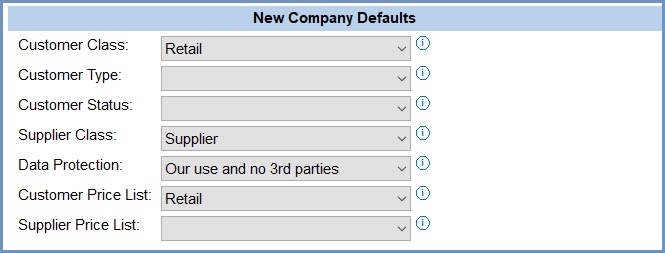System Values - General - Defaults and Financial
- WARNING: Changing these settings may cause unforeseen issues. If in doubt please check with KCSL's Support Team before making changes.
New Company Defaults
The following defaults can be setup so that when creating a new customer or supplier their record will be setup with the default options defined here. All the options must be setup before they are available here. When creating a new customer or supplier these default options can be changed if required. 
- Customer Class (default=unknown): Company Classes are setup in
[ System Data | Company Classes ]where you can define characteristics of the Company Class such as whether they are pre-payment or account customers, what their credit limit is and so on. By selecting them from the drop down, all new customers will inherit the characteristics of the Company Class assigned to them. Besides defining the options against a company, Company Classes are used in many areas of the system including accounts, promotions and they can also be reported on too. - Customer Type (default=empty): Customer Types are setup in
[ System Data | Company Types ]. This allows you to group types of customer, for example:
If you have different Company Types, it may be worth prefixing them as we have in the examples above. You can filter and report on Company Types in many different areas of the system for example sales orders and reports and you can setup promotions linked to a specified type of customer. - Customer Status (default=empty): Company Status is setup in
[ System Data | Company Status ]and is used to indicate whether the company is active or dormant. - Supplier Class (default=unknown): the Supplier Class is similar to the Customer Class except it defines the defaults for new suppliers. It is setup in
[ System Data | Company Classes ]. It enables you to separate your suppliers, so your utility suppliers are in a different class from those who sell you the stock items you sell. - Data Protection (default=Our use and no 3rd parties): setting the Data Protection when you create new companies is very important. Like many of the previous options they are setup in System Data in the
[ Data Protection ]screen. The system allows you to configure Data Protection against both companies and individual contacts within companies. - Customer Price List (default=empty): Price Lists allow you to configure different sell prices for your customers. The prices will then be automatically applied to the sales order for the customer if they qualify when the stock items are added. The Price Lists are created in
[ System Data | Price Lists ]. They are then configured in the Promotions area of the system. For the hierarchy see the notes below. - Supplier Price List (default=empty): this is where you define the default Price List for a supplier, like the previous option, it is setup in System Data. For the hierarchy see the notes below.
Notes:- If a Price List is set against a customer or supplier here, then when a new company is created it will be assigned the Price List.
- If no Price List is set here and there is a Price List set against the Company Class in
[ System Data ], then that Price List will be assigned to the new company.
Financial Setup
The Financial area is where you setup your core financial options. Once the Ledger currency has been setup this can't be changed.
- Ledger Currency (default=Pound Sterling): this is the main currency used by the system and once setup cannot be changed. It is also called the base currency and is the main currency displayed in the majority of the screens, for example in the accounts screens.
- Year End Month (default=12): this is where you add the last month of your company's end of year.
- Tax Register Month: this controls how the tax register periods are shown in
[ Tax (VAT) | Tax Register ]tab. It does NOT affect your financial year end month. - VAT Country (default=United Kingdom): this option sets the VAT country for your VAT return.
- Cleardown RC2 Information: clears down customers' name and card number data in the credit card table. The entry lines will still be present in the table but the CNUMBER and CNAME fields will have blank values.
Notes:- Khaos Control is PCI compliant and, when integrated with a payment service provider, uses a tokenisation system to exchange encrypted data with the PSP. The customer's full card details are not retained by Khaos Control.
- An existing customer's card is selected for repeat purchases by verifying the last 4 digits and the expiry date.
